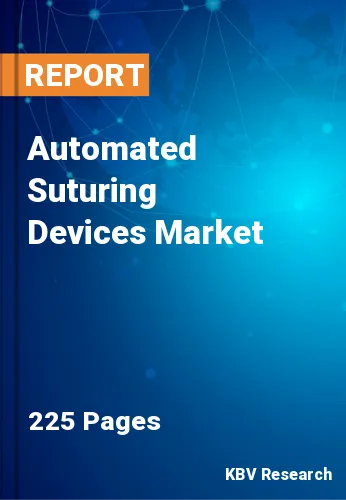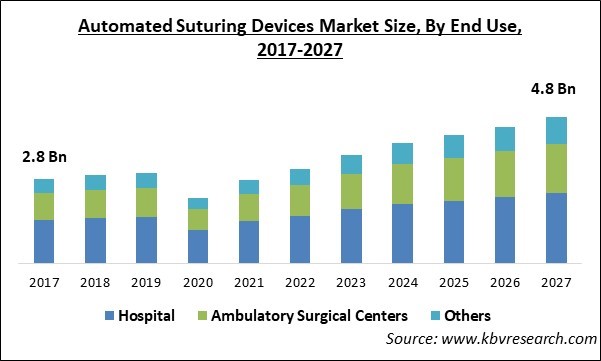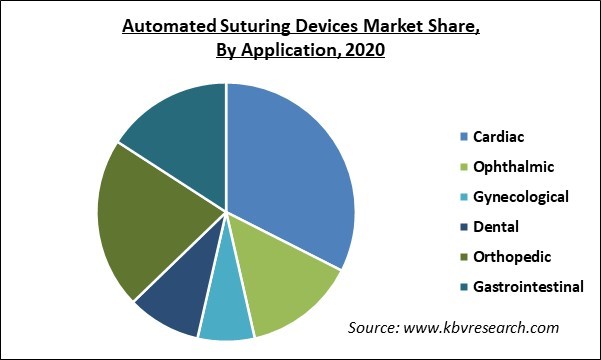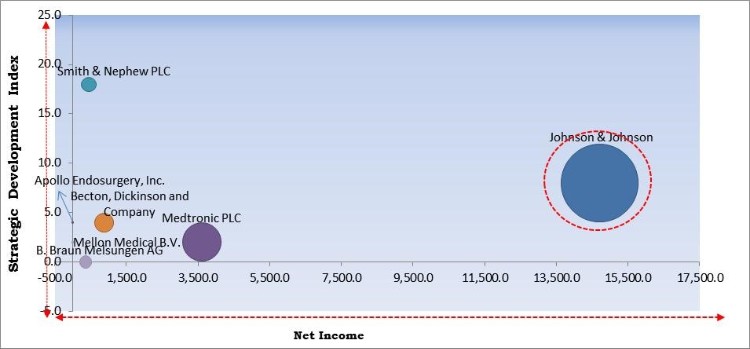
The Global Automated Suturing Devices Market size is expected to reach $4,879.4 million by 2027, rising at a market growth of 9.8% CAGR during the forecast period.
Automated suturing devices hold together the body tissues post-surgery or any stitching processes to accelerate the natural healing procedure. Automated suturing devices are used on the skin, organs, internal tissues, and blood vessels, respective to the type of wound, its anatomic location, and thickness of the skin. Automated suturing devices are used to perform a proper finishing of the wound.
As per another data shared by the PubMed Central (PMC) of the National Center for Biotechnology Information, more than 310 million major surgeries were being performed annually across the world in 2020 and are estimated to keep rising further. The rise in the number of surgeries that are being performed along with the constant rise in global annual surgery rate could play a dynamic role in the growth of the automated suturing market.
As per the data shared by NCBI, approximately 5% of the patients, after surgeries or stitching processes for any reason, annually, developed post-surgery infections caused by the bacteria that existed on the needle through which the suturing was done. Automated suturing devices lower down the risk of these post-surgery infections by offering a new opportunity of suturing with robotic assistance providing a quick and hygienic option to replace the conventional suturing processes.
Based on End-Use, the market is segmented into Hospital, Ambulatory Surgical Centers, and Others. Based on Product, the market is segmented into Reusable and Disposable. Based on Application, the market is segmented into Cardiac, Ophthalmic, Gynecological, Dental, Orthopedic, Gastrointestinal, and Others. Based on Regions, the market is segmented into North America, Europe, Asia Pacific, and Latin America, Middle East & Africa.

Apart from being a hazardous contagious virus, COVID-19 also affected the economy of every country. Production of almost all the commodities was paused, excluding some necessary goods. It also affected the manufacturing of automated suturing devices. COVID-19 caused a great fall in the growth and development of the automated suturing market.
Also, the COVID-19 lockdown tremendously enhanced the air quality on a global scale, the reduced air pollution caused by a drastic reduction in transport activities all over the world, played a major catalyst in the improved air quality. With better air quality, the risk of cardiovascular diseases became lower, thereby reducing the need for automated suturing devices in the market.
Automated suturing devices provide a partially machine-assisted suturing process to the patients. These devices eliminate the possibilities of human error during the suturing procedure and ensure a safe, better, and accurate stitching procedure to the patient with less body penetration. Furthermore, the ongoing technological advancements in the healthcare sector across various countries have significantly enhanced the productivity & accuracy of the suturing practices, and decreased the amount of time required for the entire process of suturing.
The constantly decreasing air quality across the globe due to air pollution and other factors causes more cardiovascular problems. The rising cases of cardiovascular disorders lead to an increase in the number of surgeries required to cure them. As the number of needed surgeries increases, the demand for suturing devices proportionately increases in the market. The alarming quality of air is hazardous for people, as well as a boon for the manufacturers of suturing devices.
Due to the low availability of the product, the growth of automated suturing device market may witness a downfall. The suturing devices are not being used on a very large scale which proportionately decreases its production. A huge number of surgeons still use conventional suturing methods over machine-assisted tools which restrict the growth of the market. Lack of availability also leads to a lack of skilled professionals which act as a big restraint to the growth of the automated suturing market.

Based on End-use, the Automated Suturing Market is segregated into Hospitals, Ambulatory Surgical Centers, and Others. In 2020, the hospital segment procured the biggest revenue share of the market. With a huge number of patients in need of hospital admission, this segment is expected to grow more in the upcoming years. The demand for hospital admission is constantly increasing, easily accessible hospitals along with excellent & convenient reimbursement policies may contribute to expediting the segment growth.
Based on the Product, the Automated Suturing Market is bifurcated into Disposable, and Reusable. The reusable automated suturing product held the biggest revenue share of the market. As the reusable suturing device prevents infections such as HIV, hepatitis B, and other contagious diseases that cause a lot of harm, which is a major factor in boosting the growth of the automated suturing devices market.
Based on Application, the Automated Suturing Market is segmented into Cardiac, Orthopedic, Gastrointestinal, Ophthalmic, Dental, Gynecological, and Others. The cardiac segment of the automated suturing device acquired the maximum revenue share of the market. The enormous rise in the number of patients with cardiovascular issues and disorders runs parallel with the demand for surgical procedures. The rise in the number of cardiovascular problems leads to the number of surgeries required to cure such problems.
| Report Attribute | Details |
|---|---|
| Market size value in 2020 | USD 2.2 Billion |
| Market size forecast in 2027 | USD 4,879.4 Million |
| Base Year | 2020 |
| Historical Period | 2017 to 2019 |
| Forecast Period | 2021 to 2027 |
| Revenue Growth Rate | CAGR of 9.8% from 2021 to 2027 |
| Number of Pages | 225 |
| Number of Tables | 384 |
| Report coverage | Market Trends, Revenue Estimation and Forecast, Segmentation Analysis, Regional and Country Breakdown, Competitive Landscape, Companies Strategic Developments, Company Profiling |
| Segments covered | End use, Product, Application, Region |
| Country scope | US, Canada, Mexico, Germany, UK, France, Russia, Spain, Italy, China, Japan, India, South Korea, Singapore, Malaysia, Brazil, Argentina, UAE, Saudi Arabia, South Africa, Nigeria |
| Growth Drivers |
|
| Restraints |
|
Based on Region, the Automated Suturing Market is analyzed across North America, Europe, APAC, and LAMEA. APAC region is estimated to experience the fastest rate of growth of the automated suturing devices market in the forecast period. The factors such as increasing consumer awareness and emergence of new startups focusing on the development of new treatment options and making them reachable for the audience across the region are expected to take the growth of the regional automated suturing devices to a high extent.
Free Valuable Insights: Global Automated Suturing Devices Market size to reach USD 4,879.4 Million by 2027

The major strategies followed by the market participants are Product Launches. Based on the Analysis presented in the Cardinal matrix; Johnson & Johnson is the forerunners in the Automated Suturing Devices Market. Companies such as Smith & Nephew PLC, Apollo Endosurgery, Inc., Becton, Dickinson and Company are some of the key innovators the Market.
The market research report covers the analysis of key stake holders of the market. Key companies profiled in the report include Medtronic PLC, Smith & Nephew PLC, Johnson and Johnson (Ethicon, Inc.), Apollo Endosurgery, Inc., Boston Scientific Corporation, Becton, Dickinson and Company, B. Braun Melsungen AG, DemeTECH Corporation, Mellon Medical B.V., and LSI Solutions, Inc.
By End-Use
By Product
By Application
By Geography
The global automated suturing devices market size is expected to reach $4,879.4 million by 2027.
Increased accuracy due to decreased human error are driving the market in coming years, however, low availability of the device have limited the growth of the market.
Medtronic PLC, Smith & Nephew PLC, Johnson and Johnson (Ethicon, Inc.), Apollo Endosurgery, Inc., Boston Scientific Corporation, Becton, Dickinson and Company, B. Braun Melsungen AG, DemeTECH Corporation, Mellon Medical B.V., and LSI Solutions, Inc.
Yes, Due to drastic reduction in transport activities all over the world, played a major catalyst in the improved air quality. With better air quality, the risk of cardiovascular diseases became lower, thereby reducing the need for automated suturing devices in the market.
The Disposable market is expected to witness highest CAGR of 11.2% during (2021 - 2027). As the disposable segment of the automated suturing devices is a single-use wound closing device that allows the user to replace the used needle with a new needle.
The North America market dominated the Global Automated Suturing Devices Market by Region 2020, and would continue to be a dominant market till 2027; thereby, achieving a market value of $1,796.1 million by 2027.
Our team of dedicated experts can provide you with attractive expansion opportunities for your business.
